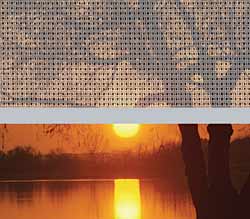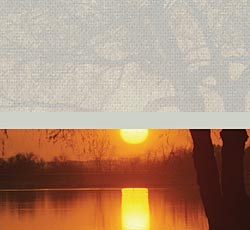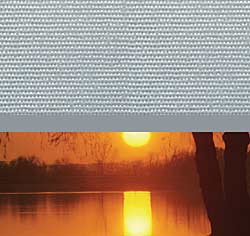Daylight in the Office Space
Openness Factor
A roller shade fabric is woven together with fine threads or yarns. The openness factor of a fabric describes the ratio of open space to fabric material in a weave, which is essentially how much shade is not there. For example, a shade with 10 percent openness means that 10 percent of the physical shade is open space. The broader the open space between the threads, the greater the openness factor. The shade fabric's ability to reflect or absorb solar energy is determined, in part, by the amount of fabric present to either reflect or trap the sun's rays.
|
||||||||||||||
Fabrics are available in a variety of openness factors, including (1 percent, 3 percent, 5 percent, 8 percent, 10 percent, and 18 percent openness), privacy and blackout. Privacy fabrics refer to fabrics that have an openness factor of less than 1 percent, but greater than 0 percent. Blackout fabrics offer 0 percent openness, transmitting no light into the interior. The wide range of available openness factors caters to different project priorities and natural light control expectations. Each is uniquely suited to meet the different requirements of a project.
Specifying a fabric with a higher openness factor will provide a clearer view. However, as the openness factor increases, more unfiltered light and heat energy pass through the shade into the building, increasing the risk of glare and solar heat gain, and reducing the amount of protection against UV radiation that the shade is able to provide.
|
||||||||||||||
In many projects, different openness factors may be required on one building to provide optimal daylighting performance. The orientation and latitude of a building, in relationship to the sun and the rotation of the Earth, dictate that building's exposure to direct sunlight. To effectively diffuse the direct sunlight in these highly exposed areas, the shade fabric must be denser. Sides of the building with less direct exposure may permit a broader openness factor, allowing more light into the space, without the threat of glare.
In the northern hemisphere, southern- and eastern-facing building facades receive more intense solar exposure throughout the day. On these facades, it may be prudent to specify a three percent openness factor to appropriately filter direct sunlight and protect against glare, while a 10 percent openness factor could be ideal on the north-facing window wall, to permit more of the less available light into the space. Today, many shade fabrics are available in several openness factors. Different openness factors of the same fabric may be specified on different facades of the same building to effectively manage different exposures to direct sunlight, without compromising curb appeal.
|
||||||||||||||
Shade selection is not a zero-sum game. Designers can protect against solar heat gain and UV radiation, while providing an outdoor view, instead of having to choose one or the other. A 10 percent openness factor provides great visibility, but allows more light and heat penetration into a space, which can cause glare and solar heat gain. A three percent openness factor filters more sunlight and, subsequently, provides more glare control and UV protection, but limits the view to shapes and shadows. An openness factor of one percent and lower allows the glow of exterior light into a space, but provides very little visibility.
As the openness factor increases, so does the solar transmittance (Ts) value. Both color and composition of the shade fabric influence how much of the remaining solar radiation is reflected or absorbed, as well as, the visual transmittance of the fabric.












